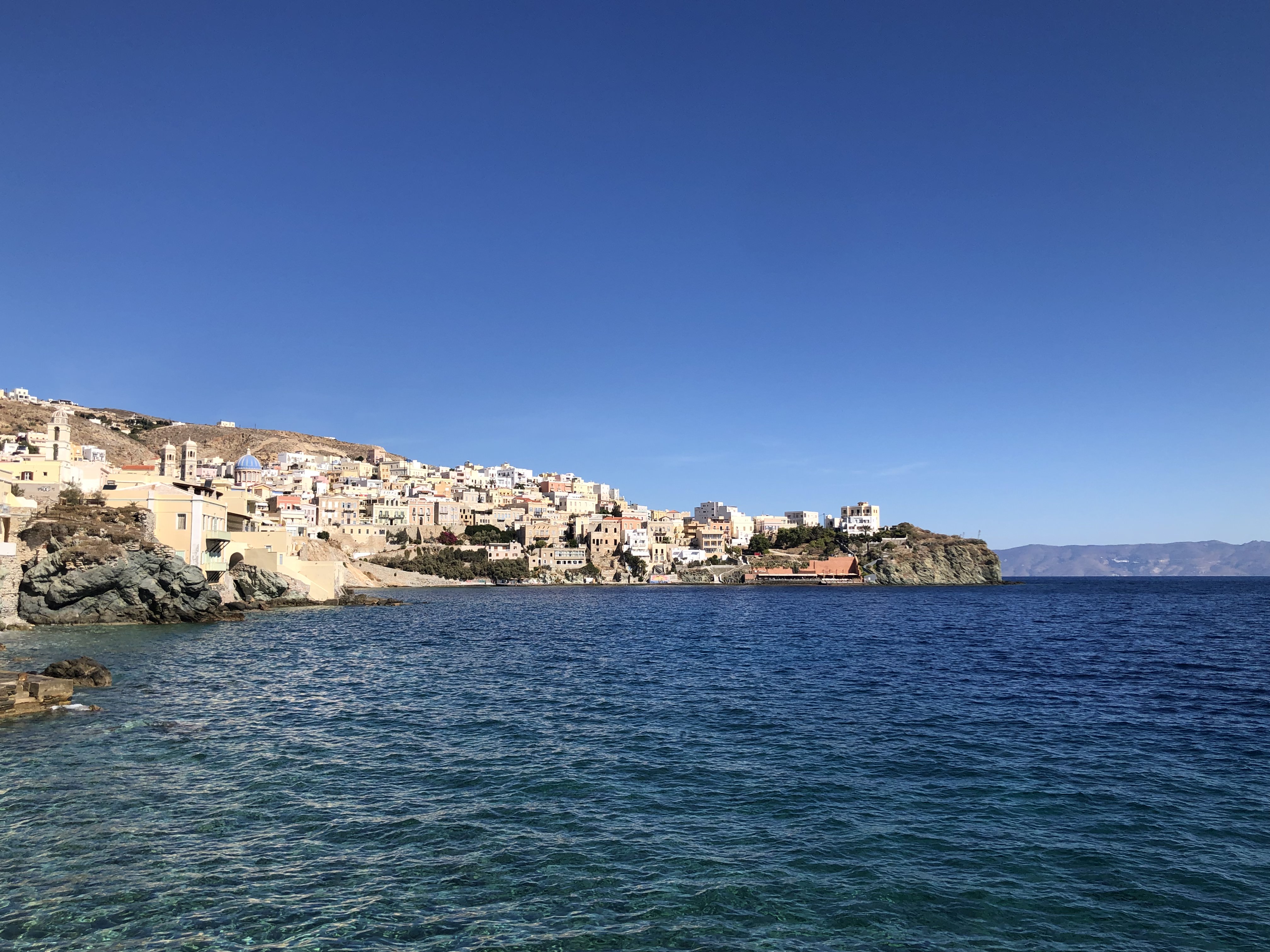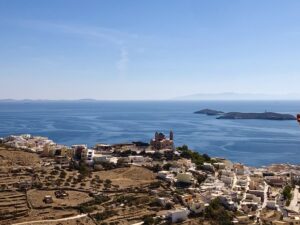Just a short boat ride away from over-visited neighbor Mykonos island, lies elegant, historic, cultural and architecturally fascinating Syros; the two islands are almost polar opposites, despite the fact that only a 45-minute ferry ride separates them!
The historic harbor town of Ermoupoli (named after God Hermes), the capital of Syros as well as the Cyclades, has plenty of life all year round making it a great destination for an off-season island trip. It is home to a cosmopolitan mix of people – an extension of its fascinating past.
By the time the ferry enters the harbor, one can admire the town that climbs to two hills, each topped with a church. One is the Orthodox hill, and the other Roman Catholic. The pastel colors of the buildings as you approach it on the ferry are just dreamy!
During my four days trip to Syros last week, as I was strolling around the picturesque alleys of Ermoupolis, I found it difficult to believe that this town is still less than two centuries old, and also difficult to feel that I was in the Cyclades. The architecture is much different from most cycladic port villages with the typical whitewashed, sugar-cube houses (you will find some of them if you head up to the village of Ano Syros, meaning Upper Syros).
In Ermoupoli you will come across imposing 19th century neoclassical mansions with marble fittings and houses with ornate corbels that give the island an air of eclectic grandeur. Bear in mind that during the 1800s, Syros was the wealthiest region in Greece and the regional powerhouse for textiles with more than 24 textile factories, thus the nickname “Switzerland of the Aegean”.
The non-profit Hermoupolis Heritage offers fascinating experiential tours of Syros’ industrial past that I highly recommend. The tour begins after dusk in a fairy-like atmosphere. I was welcomed by a young girl who was wearing an old gray apron – like the ones once worn by the factory workers-and holding an old-fashioned lantern in her hand. She offered me a shot of Mastiha liqueur before she led the way inside the remnants of Zisimatos textile factory. For a more holistic approach to Syros industrial heritage, pay a visit to the Industrial Museum of Ermoupolis. It houses the Enfield 8000 ( a two-seater battery-electric city car, built in Greece in the 70’s and many more exhibits that eloquently narrate the island’s industrial history.
But there was more to discover on my urban walks around the alleys of Ermoupoli. First and foremost, the island’s architectural wealth. Designed by German architect Ernst Ziller, the Ermoupoli Town Hall, one of the biggest in Greece, is the city’s most striking building. Its construction began in 1876 and was completed in 1898. Just a few meters away, lies the municipal Apollon Theater– a replica of the famous Scala di Milano, but on a smaller scale- symbolizing the cultural development of Ermoupoli. Built between 1862 and 1864, it was launched with a production of the opera “Rigoletto” by Guiseppe Verdi. The extraordinary ceiling paintings depicting poets and composers were created by Dimitris Fortsas during renovation work conducted on the building in 1998.
With respect to its urban past, modern Ermoupoli is home to many concept stores that you will find as you stroll around the narrow alleys of the town. Hydora was the one closest to my hotel, but then I passed by many more such as Normless Terra store, Syracuse, Lousou, Chimera Art and `Craft and my beloved Kriari, where I discovered a great collection of Greek designers’ clothing and accessories.
Syros is not only rich in history, but also full of cosmopolitan energy. It is world-renowned for its rich cultural tradition with events taking place in Ermoupolis, such as the International Classical Music Festival of Cyclades, Syros International Film Festival, ANIMASYROS International Animation Festival, Syros Jazz Festival, Syros Tango Festival, Akropoditi Dance Festival, Rembetiko (urban Greek music) Festival, and many more that offer a wide range of options for every visitor to experience. You only have to discover which Festival you belong to.
In Vaporia, I had the time of my life! It is the island’s former aristocratic neighborhood where I admired stunning 19th century mansions and captain’s houses built on a hill licked by the sea. When I felt somehow tired walking, I had a refreshing swim at Asteria beach. It’s actually a concrete deck over the sea where you can swim and soak up the sun. The views from here are some of the best in the town, with the blue-domed Agios Nikolaos and the beautiful villas in the background. There are also many a beach around the island, and some that can only be reached by boat, but unfortunately I run out of time to go and visit them. I will just have to go back another time and check them out!
Irrepressible foodies- like me- will be enthused by the abundance of local products that Syros island has to offer to the modern traveler. Many grocery stores and pastry workshops lay out their produce and share their mouth watering delicacies: from cheeses and sausages (try out slightly sweet, spiced loutza and maratholoukanika), light jams, capers, oreganon, exquisite organic herbs, cycladic organic infusions and honey, and the famous local deserts such as loukoumia (delights), amygdalota (almond cookies) and halvadopita (nugat pie). Don’t leave the island without trying xynotyro, marathotyri, graviera (gruyere) and the famous PDO San Michali cheese – ask for the well-matured type and, please, pair it with some local wines from the two local wineries Ousyra and Syros. I personally felt in love with Fabrica, by Syros Winery, that definitely carries the cosmopolitan air of Syros. This cycladic jewel is a crisp, fruity white from the varieties Monemvasia and Kountoura. It has a pale lemon color and delicate aromas of pear, lemon, citron, bergamot, and peach accompanied by notes of white flowers and herbs!
The time flew by and I had to leave the island and its friendly people. As the boat departed from the harbor, we waved goodbye to Syros and Ermoupoli but also to the nostalgic stone-built lighthouse on Gaidouronisi, one of the first ever built in Greece. The lighthouse was telling me ‘kalimera’ every morning when I was opening my room’s shutters, giving me the feeling that it silently safeguards the island’s fascinating urban culture, old and contemporary. Visit site
Blog post by Miss More


0 Comments